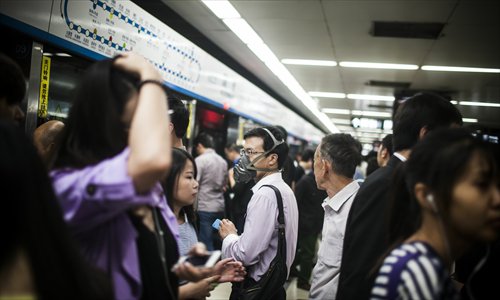HOME >> LIFE, METRO BEIJING
Subway smog
By Zhang Xinyuan Source:Global Times Published: 2014-12-2 19:33:01
Passengers learn to battle poor air quality underground

Subway passengers wear masks to combat air quality that is reportedly worse than aboveground. Photo: Li Hao/GT
Fearing poisonous particulates in the air, Zhu Huiqi makes absolutely sure she has clean air everywhere. She installed air purifiers in her home and office, and she always wears a mask when she ventures outside.When riding the subway, however, she does not wear a mask. She figured the subway was technically indoors and, therefore, more likely to have cleaner air.
Little did she know the air underground is actually worse than that aboveground.
The Green Beagle Institute, a non-governmental environmental research institute founded in Beijing in 2009, conducted an air quality test in Guloudajie Station on lines 2 and 8 last January, finding that the PM 2.5 level in the subway station was 16 times that of outside.
"The PM 2.5 concentration was eight outside that day, 129 on the subway platform, and 72 in the subway car," said He Xiaoxia, the head of the Green Beagle Institute.
The main source of air pollution in the subway mainly comes from dust particles, which are produced when the subway wheels and railway tracks clash together, according to research by the King's College of London that was published in The Daily Mail last May. When researchers conducted a PM 2.5 test in the London Underground, they found the reading in the subway was 64 when it was only 1 outside.
Xie Shaodong, associate dean of Peking University's College of Environmental Sciences and Engineering, said other sources of air pollution in the subway include gas emitted by construction materials, as well as carbon dioxide and dust exuded by overcrowded passengers, all of which is exacerbated by an inadequate underground ventilation and filtration system.
"The Beijing subway needs to increase its ventilation facilities and make sure its air ducts have reasonable locations, far away from contamination sites aboveground," he said.
Xie also said Beijing should install air quality monitors in its subways so that passengers could be better informed of what the air quality is like.
Many lines of the Beijing subway are facing the problem of an inadequate ventilation system, according to a report published in the Beijing Evening News in September 2013. The Xinjiekou Station on Line 4, for example, has some air vents located near a trash station and public toilets, while others are blocked by buildings.
"Sometimes I feel suffocated and a little dizzy if I ride the subway for a long time," Zhu said. "I thought it was car sickness. I never thought the problem was the air."
Liu Zeying, a doctor at Beijing Anzhen Hospital's department of respiratory medicine, said it is important that passengers remember to wear their pollution masks when riding the subway.
"Try not to stay too close to the railway track, considering that's the main source of air pollution when waiting on the platform," Liu said.
Hope for better air may come with changes in Beijing subway's transportation fees. The Beijing Subway has been in deficit due to its 2 yuan ($0.33) flat rate fare for using the transportation system. It lost 330 million yuan last year, according to a 21st Century Business Herald report last month.
To reverse the deficit and control passenger volume, Beijing decided to increase the ticket fare for the public transportation system, starting December 28. Under the new pricing system, the fare will increase according to a passenger's travel mileage.
"My daily expense on the subway will increase from 4 yuan to about 20 yuan," Zhu said. "I hope that after the price hike, Beijing subway will employ more measures to improve the air quality in there since they would have the resources to do so."
As of press date, Metropolitan hasn't received any comments from the Beijing Subway about their plans to improve air quality.
Posted in: Miscellany, Metro Beijing